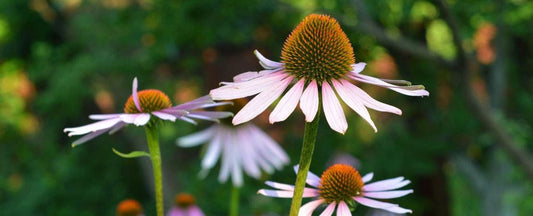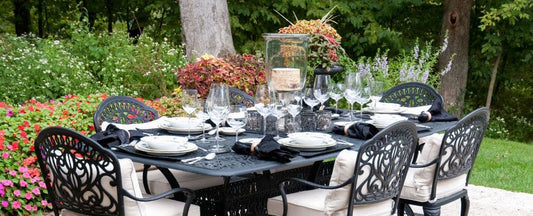Ultimate Planting Guide: 30 Perennials for Almost All US Growing Zones

Plants That Thrive Nationwide, U.S. Zones (3-10+)
When designing a low-maintenance, high-impact garden, choosing the right plants is essential. Certain hardy perennials thrive in nearly every U.S. growing zone, from the frigid winters of Minnesota to the sunny landscapes of Florida.
These versatile plants adapt to different climates, giving your garden beauty, blooms, and long-lasting structure. Perennials that made the list are highly adaptable, hardy, and can help you design a beautiful and resilient garden in different climates.
How to Use This Guide
- Find perennials suited to your climate: Cold (Zones 3-5), Moderate (Zones 6-7), or Warm (Zones 8-10+).
- Select plants based on garden conditions: Sun or shade, dry or moist soil.
- Ensure continuous blooms: Choose plants that flower at different times of the year.
NOTE: Zones listed are general. Different species within the genus may grow best in a sub-set of the Zones listed. Consult our product pages to find the Zone range for the specific plants you want to grow.
Achillea (Yarrow) – Zones 3-8
A drought-tolerant powerhouse, yarrow has clusters of tiny flowers in yellow, pink, red, or white. This butterfly magnet thrives in dry, sandy soils and resists deer and rabbits. Yarrow is a great choice for low-maintenance landscapes.
Ajuga (Bugleweed) – Zones 4-11
This evergreen groundcover features vibrant foliage in deep purples, greens, and bronzes, accented in springtime with blue or purple flower spikes. Ajuga thrives in shade or sun and quickly fills in bare spots in garden beds.
Allium (Ornamental Onion) – Zones 4-8
Alliums are striking architectural plants known for their globe-shaped flower heads that rise on tall stems in late spring. These deer-resistant perennials add dramatic vertical interest and work beautifully in formal and cottage gardens.
Amsonia (Blue Star) – Zones 4-9
A hidden gem in perennial gardening, amsonia has clusters of soft blue flowers in spring and brilliant golden foliage in fall. Amsonia is low maintenance with feathery leaves that add texture to mixed borders while remaining resistant to pests and diseases.
Aquilegia (Columbine) – Zones 3-10
A shade-loving perennial with graceful, spurred flowers in bright reds, blues, purples, and yellows. Columbine thrives in woodland settings and attracts hummingbirds, making it perfect for pollinator-friendly gardens.
Asclepias (Milkweed) – Zones 3-9
Milkweed provides nectar-rich blooms while serving as the only host plant for monarch caterpillars. It thrives in poor soil, full sun, and low-water conditions. The umbelliferous blooms make it easy for pollinators to access milkweed’s nectar.
Aster (Aster, Symphyotrichum) – Zones 3-10
Aster is a late-season favorite, blooming in shades of purple, pink, and white when most other plants fade. Its nectar-rich flowers support bees and butterflies well into fall, extending your garden’s seasons of interest.
Baptisia (False Indigo) – Zones 4-9
Baptista is a shrub-like native perennial that produces pea-like flowers in deep blue, yellow, or white. It is long lived, drought resistant, deer repelling, and requires little care, making it a favorite for low-maintenance gardens.
Coreopsis (Tickseed) – Zones 5-9
A garden staple, coreopsis features sun loving, cheerful, daisy-like blooms that rebloom all summer long. Highly adaptable, it thrives in dry, sandy soils, tolerates heat, and attracts pollinators while resisting deer.
Dianthus (Pinks, Carnations) – Zones 4-9
Known for their fragrant, fringed flowers, dianthus blooms in pink, red, white, lavender, and bi-colors. Perennial dianthus thrives in well-drained soil and full sun, making it perfect for borders, rock gardens, and edging.
Echinacea (Coneflower) – Zones 3-9
One of the most resilient perennials, echinacea has bold, daisy-like flowers in shades of purple, orange, pink, and white. Drought-tolerant, pollinator-friendly, and with seed heads that feed birds in winter, coneflowers provide long-lasting beauty in the garden.
Epimedium (Barrenwort) – Zones 5-9
A top performer for shade gardens, epimedium has delicate, heart-shaped flowers and evergreen foliage. It thrives in dry conditions, making it an excellent ground cover for underplanting beneath trees and shrubs
Geranium (Hardy Geranium, Cranesbill) – Zones 5-8
Unlike its annual counterpart, hardy geraniums produce long-lasting, bowl-shaped flowers with attractive, rounded foliage. Cranesbill geraniums are disease-resistant, long-lived, and adaptable to sun or shade.
Hemerocallis (Daylily) – Zones 3-9
Daylilies are virtually indestructible perennials, blooming in an endless range of colors. Their strappy foliage and ability to thrive in poor soil, drought, and heavy clay make them a garden favorite.
Heuchera (Coral Bells) – Zones 4-9
Known for stunning foliage in shades of purple, caramel, silver, and lime green, coral bells provide year-round interest. Their delicate flower spikes attract pollinators, while their evergreen leaves add color in winter.
Hosta (Hosta, Plantain Lily) - Zones 3-9
Hosta's are a shade garden favorite with lush, textured foliage in green, blue, and variegated varieties. Their low-maintenance nature and tolerance for moist, shady conditions make them indispensable in wet areas in the landscape.
Iris (Bearded & Siberian Iris) – Zones 3-10
Irises are long lived and their unique blooms are available in a rainbow of colors. Their sword-like foliage adds architectural appeal, while their ability to thrive in wet or dry soil shows their adaptability.
Monarda (Bee Balm) – Zones 4-9
Bee balm’s vibrant red, pink, and purple flowers attract hummingbirds and butterflies. This fast-growing perennial flourishes in sunny, moist conditions and is known for its fragrant, mildew-resistant foliage.
Sedum (Stonecrop) – Zones 3-11
Sedum is one of the toughest perennials with thick, succulent-like leaves and late-season blooms that bees adore. Its ability to thrive in poor soil and extreme conditions makes it a low maintenance addition to the garden. Sedum is ideal for rock gardens, too.
Lavandula (Lavender) – Zones 5-9
Famous for its soothing fragrance and silvery-green foliage, lavender thrives in full sun and well-drained soil. This drought-resistant perennial is popular for cottage gardens, borders, and pollinator beds.
Penstemon (Beardtongue) – Zones 3-8
Penstemon produces tall spikes of tubular flowers that attract hummingbirds in sunny gardens. Its low-water needs, heat tolerance, and long bloom time make it a garden favorite.
Phlox (Creeping & Tall Garden Phlox) – Zones 3-9
Phlox offers variety with fragrant, long-lasting blooms in muted or vibrant shades of pink, purple, and white. Creeping phlox forms a dense groundcover, while garden phlox adds vertical beauty to mixed borders. Phlox prefer full sun to partial shade and well-drained soil.
Rudbeckia (Black-Eyed Susan) – Zones 3-10
Rudbeckia is a mid to late-summer favorite. The best-know flowers have bold, golden-yellow blooms that attract pollinators, but reds and pastels shades are available too. Deer-resistant and drought-tolerant, it provides long-lasting color in the landscape.
Salvia (Sage) – Zones 3-9
Salvia’s spiky blooms in purple, blue, and red are a magnet for bees and butterflies. Drought-tolerant and low-maintenance, salvia thrives in full sun and well-drained soil.
Verbena – Zones 6-10
Verbena is a heat-tolerant, long-blooming perennial that forms a sprawling mass of vibrant purple, pink, or red flowers. Thriving in full sun and dry conditions, it is an essential pollinator plant and an excellent choice for containers, borders, and rock gardens.
Veronica (Speedwell) – Zones 3-9
A compact, easy-care perennial, veronica has spiky, upright blooms in shades of blue, pink, purple, or white. Loved by pollinators and resistant to deer, it adds vertical interest and a long bloom period to perennial beds and borders.
Viola (Violets, Pansies, Johnny Jump-Ups) – Zones 4-8
Violas offer early-season color with cool-weather resilience. Their cheerful, dainty blooms in purple, yellow, white, and blue are adaptable to sun or partial shade. These cool-weather perennials are perfect for edging,
How to Plan a Perennial Garden for Year-Round Color
Step 1: Layer Plants by Bloom Time
- Early bloomers(Spring): phlox, viola, tiarella, aquilegia.
- Mid-season bloomers(Summer): echinacea, rudbeckia, daylilies, coreopsis.
- Late-season bloomers(Fall): asters, sedum, veronica.
Step 2: Group by Growing Conditions
- Full Sun, Drought-Tolerant: lavender, salvia, verbena, sedum.
- Partial Shade, Moist Soil: Hosta, heuchera, tiarella, thalictrum.
- Pollinator-Friendly Garden: milkweed, monarda, coneflower, black-eyed Susan.
- Deer Resistant: Allium, dianthus, iris, cranesbill geranium.
Step 3: Add Perennials for Texture & Contrast
- Feathery foliage: meadow rue (Thalictrum), yarrow (Achillea).
- Bold, large leaves: Hosta, heuchera, baptisia.
- Fine-textured groundcover: ajuga, veronica, creeping phlox.
Bonus Tips for Deer-Resistant Landscaping:
- Use strong scents– Planting herbs like lavender, rosemary, and thyme near susceptible plants can deter deer.
- Incorporate texture– Deer avoid fuzzy, tough, or leathery foliage, such as lamb’s ear (Stachys byzantine).
- Rotate deterrents – Using deer repellents and mixing in resistant plants increases effectiveness.

For premium perennials suited to your region, shop Wayside Gardens.
































